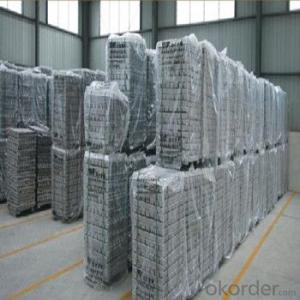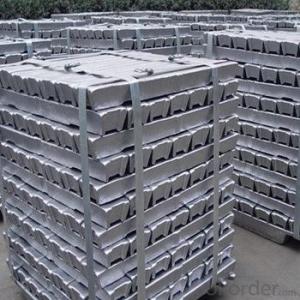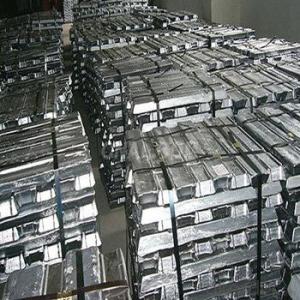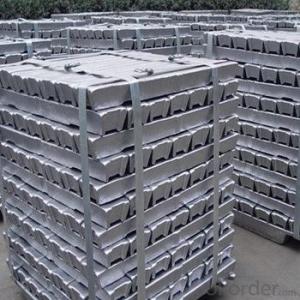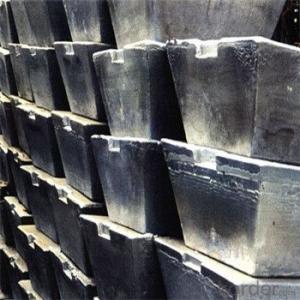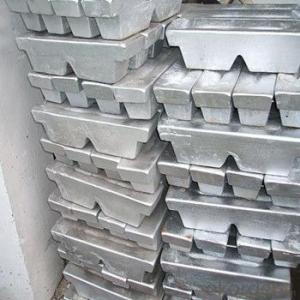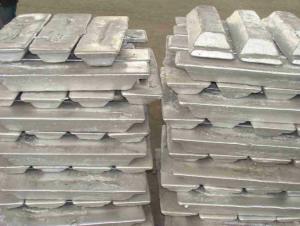Aluminum Ingot From Chinese Supplier Best Quanlity
- Loading Port:
- China main port
- Payment Terms:
- TT OR LC
- Min Order Qty:
- 1000 m.t.
- Supply Capability:
- 10000 m.t./month
OKorder Service Pledge
OKorder Financial Service
You Might Also Like
Pure Aluminum Ingot Used for Industry
1.Structure of Aluminum Ingot Description
An ingot is a piece of material, usually metal, that is cast into a shape suitable for further processing. Insteelmaking, it is the first step among semi-finished casting products.
2.Main Features of the Aluminum Ingot
•Easy control and operation
•Fast melting
•Good price
•Good Service
3. Aluminum Ingot Images
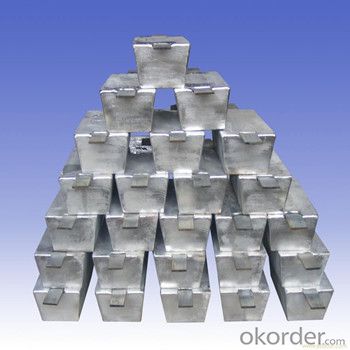
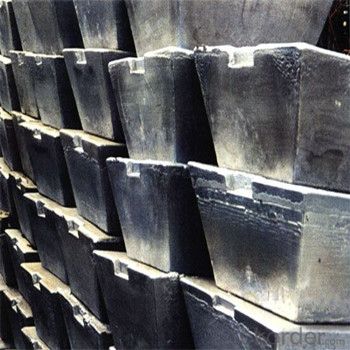
4. Aluminum Ingot Specification
Grade | Chemical Composition % | |||||||||
Al≥ | impurities ≤ | |||||||||
Si | Fe | Cu | Ga | Mg | Zn | Mn | others | Sum | ||
Al99.9 | 99.90 | 0.50 | 0.07 | 0.005 | 0.02 | 0.01 | 0.025 | - | 0.010 | 0.10 |
Al99.85 | 99.85 | 0.80 | 0.12 | 0.005 | 0.03 | 0.02 | 0.030 | - | 0.015 | 0.15 |
Al99.7 | 99.70 | 0.10 | 0.20 | 0.010 | 0.03 | 0.02 | 0.030 | - | 0.030 | 0.30 |
Al99.6 | 99.60 | 0.16 | 0.25 | 0.010 | 0.03 | 0.03 | 0.030 | - | 0.030 | 0.40 |
Al99.5 | 99.50 | 0.22 | 0.30 | 0.020 | 0.03 | 0.05 | 0.050 | - | 0.030 | 0.50 |
Al99.00 | 99.00 | 0.42 | 0.50 | 0.020 | 0.03 | 0.05 | 0.050 | - | 0.050 | 1.00 |
5.FAQ of Aluminum Ingot
We have organized several common questions for our clients,may help you sincerely:
①How about your company?
A world class manufacturer & supplier of castings forging in carbon steel and alloy steel,is one of the large-scale professional investment casting production bases in China,consisting of both casting foundry forging and machining factory. Annually more than 8000 tons Precision casting and forging parts are exported to markets in Europe,America and Japan. OEM casting and forging service available according to customer’s requirements.
②How to guarantee the quality of the products?
We have established the international advanced quality management system,every link from raw material to final product we have strict quality test;We resolutely put an end to unqualified products flowing into the market. At the same time, we will provide necessary follow-up service assurance.
③How long can we receive the product after purchase?
In the purchase of product within three working days, We will arrange the factory delivery as soon as possible. The pecific time of receiving is related to the state and position of customers.Commonly 7 to 10 working days can be served.
- Q:How are aluminum ingots used in the production of lighting fixtures?
- Aluminum ingots are used in the production of lighting fixtures as they serve as the primary material for constructing the fixtures' bodies and frames. The ingots are melted down and then cast into various shapes and sizes, allowing manufacturers to create durable and lightweight components for the fixtures. Additionally, the aluminum's excellent thermal conductivity helps dissipate heat efficiently, making it a suitable material for light fixtures that require effective heat management.
- Q:Lead and Feng Sheng aluminum profile which is better
- Feng and are relatively old brand Zhensheng aluminum, but the aluminum wall thickness is thin, generally only 0.8mm, the thick wall has some 1mm problems, so some of the relatively strong vibration or aluminum. In addition to the surface gloss than aluminum Zhensheng, with some. Now on the market a lot of counterfeit goods at the Al Feng, ordinary people can not recognize it
- Q:Does aluminum ingots produced without aluminum ore belong to metal smelting?
- Smelting principle1. reduction method: metal oxides (together with reducing agents) - free metals2., replacement method: metal salt solution (add active metal) - free metal3. electrolysis: molten metal salts (electrolysis) - - free metals (metal elements)
- Q:How are aluminum ingots used in the production of electronic devices?
- Aluminum ingots find various applications in the manufacturing of electronic devices. To begin with, aluminum, being a lightweight and robust metal, is an ideal choice for producing casings or housings for electronic devices. These ingots are melted and cast into specific shapes to form the outer shells of smartphones, laptops, tablets, and even gaming consoles. Moreover, aluminum possesses exceptional conductivity for both electricity and heat. Consequently, it is frequently employed as a heat sink material in electronic devices to dissipate excess heat generated during operation. The ingots are processed into heat sinks, which are then incorporated into components like processors, graphics cards, and power modules. The high thermal conductivity of aluminum aids in maintaining optimal operating temperatures, preventing overheating, and ensuring the longevity and performance of electronic devices. Furthermore, aluminum ingots are also utilized in the production of printed circuit boards (PCBs). PCBs serve as the foundation for assembling and connecting various electronic components, making them essential for electronic devices. Aluminum is used as a base material for manufacturing PCBs due to its mechanical strength and electrical insulation properties. The ingots are processed into thin sheets that function as the base substrate for mounting electronic components, establishing a solid foundation for the functionality of the devices. In conclusion, aluminum ingots play a vital role in the production of electronic devices. They are employed in creating lightweight and durable casings, heat sinks for effective thermal management, and base materials for PCBs. With its exceptional electrical conductivity, heat dissipation capabilities, and mechanical strength, aluminum significantly contributes to the overall performance, reliability, and efficiency of electronic devices.
- Q:What are the different recycling methods for aluminum ingots?
- There are several different recycling methods for aluminum ingots, each with its own advantages and applications. One of the most common methods is called mechanical recycling, or shredding and melting. In this process, aluminum ingots are shredded into small pieces and then melted down in a furnace. The molten aluminum is then cast into new ingots or other forms for reuse. Mechanical recycling is highly efficient and can be used to recycle a wide range of aluminum products, including cans, automotive parts, and building materials. Another method is called smelting, which involves the use of a high-temperature furnace to separate aluminum from other materials. The aluminum is melted and then refined to remove impurities before being cast into ingots. Smelting is often used for recycling aluminum from industrial waste, such as scrap metal or manufacturing byproducts. Chemical recycling is another approach, which involves breaking down aluminum into its basic components using chemical reactions. This method is particularly useful for recycling aluminum from complex products, such as electronic waste or composite materials. The broken-down aluminum can then be used to produce new ingots or other aluminum products. Lastly, there is a method called electrolysis, which uses an electric current to separate aluminum from its oxide form. This process is energy-intensive but can be highly efficient in recycling aluminum from certain sources, such as aluminum dross or smelter slag. Electrolysis is commonly used in the aluminum industry to produce high-quality ingots with specific characteristics. Overall, these different recycling methods for aluminum ingots offer various benefits, including reducing the demand for virgin aluminum, saving energy, and reducing environmental impact. By choosing the appropriate recycling method based on the type of aluminum waste, we can ensure a more sustainable and circular economy for this valuable resource.
- Q:How are aluminum ingots shaped into different forms?
- The process of aluminum extrusion involves shaping aluminum ingots into various forms. First, the ingot is heated until it becomes molten. Then, the molten aluminum is forced through a specially designed die, which determines the final product's shape and size. The die, acting as a mold, is a hollow profile with the desired shape. Once the molten aluminum passes through the die, it undergoes a cooling process to solidify it into the desired shape. Cooling methods such as air cooling or water quenching can be used, depending on the product's specific requirements. After the aluminum has cooled and solidified, it is cut to the desired length. This can be done during or after the extrusion process, depending on the shape's complexity or the product's requirements. Aluminum extrusion offers a wide range of possibilities for shape production, including solid profiles, hollow sections, tubes, and intricate designs. This highly versatile and efficient process is a popular choice for shaping aluminum into different forms. Moreover, aluminum's lightweight and corrosion-resistant properties make it an ideal material for various applications, ranging from the construction and automotive industries to consumer goods and electronics.
- Q:What are the environmental impacts of producing aluminum ingots?
- The environmental impacts associated with the production of aluminum ingots are diverse. One major concern revolves around the extraction of bauxite, the primary ore used in aluminum production. The mining process, which often involves deforestation and habitat destruction, leads to the loss of biodiversity and disrupts ecosystems. Refining bauxite into alumina, a precursor to aluminum, demands significant amounts of energy. Typically, this energy is sourced from non-renewable fuels like coal or natural gas, resulting in greenhouse gas emissions and contributing to climate change. Subsequently, electrolysis is employed to convert alumina into aluminum metal, necessitating substantial electricity consumption. If this electricity is generated from fossil fuel-based power plants, it further exacerbates greenhouse gas emissions. Nevertheless, some aluminum smelters are transitioning to renewable energy sources, which aids in reducing their carbon footprint. The production of aluminum ingots also generates waste and by-products. The residue left after extracting alumina, known as red mud, possesses high alkalinity. If not properly managed, this residue can pose risks to soil and water quality and harm aquatic life if it enters nearby water bodies. Moreover, the transportation of bauxite, alumina, and aluminum ingots over long distances contributes to carbon emissions and air pollution. The extraction and production processes may also require the utilization of chemicals and other resources, which, if not properly managed, can have negative impacts on local ecosystems and water sources. In conclusion, the production of aluminum ingots entails various environmental impacts, including deforestation, greenhouse gas emissions, waste generation, and potential water and soil pollution. However, the industry is actively striving to address these concerns through the adoption of renewable energy, improved waste management practices, and resource efficiency measures.
- Q:Can aluminum ingots be used in medical applications?
- Yes, aluminum ingots can be used in certain medical applications. Aluminum is lightweight, non-toxic, and has excellent corrosion resistance, making it suitable for medical devices such as orthopedic implants, prosthetics, and surgical instruments. However, it is important to note that aluminum should meet specific medical grade standards to ensure its safety and compatibility with biological systems.
- Q:How is aluminum ingot different from aluminum billet?
- Aluminum ingots and aluminum billets are two variations of aluminum metal that vary in terms of their form, dimensions, and manufacturing techniques. Typically, aluminum ingots are produced through a primary aluminum production method known as smelting. These ingots are solid blocks or slabs of aluminum with a standardized shape and size, resembling a large rectangle. The production process involves pouring molten aluminum into a mold and allowing it to cool and solidify. Aluminum ingots serve as essential raw materials for subsequent processing, including rolling, extrusion, or forging, enabling the creation of diverse aluminum products. On the other hand, aluminum billets are semi-finished goods that are often derived from aluminum ingots. The creation of billets involves heating and continuously casting molten aluminum into a cylindrical form, which is then cooled and solidified. Unlike ingots, billets possess a smaller cross-sectional area and a longer length. They are primarily employed as starting materials for extrusion processes. In these processes, billets are heated and pushed through a die, enabling the production of intricate shapes such as rods, bars, profiles, or tubes. In conclusion, despite being composed of the same material, aluminum ingots and aluminum billets differ in their form, dimensions, and purpose. Ingots serve as large rectangular blocks, utilized as raw materials for further processing, while billets are smaller cylindrical shapes employed as the initial materials for extrusion processes.
- Q:What are the global production trends for aluminum ingots?
- The global production trends for aluminum ingots have been steadily increasing over the years. Aluminum is one of the most widely used metals in various industries, including aerospace, automotive, construction, and packaging. This demand has driven the growth of aluminum ingot production globally. The Asia-Pacific region, particularly China, has emerged as the largest producer of aluminum ingots. China's rapid industrialization and infrastructure development have significantly contributed to its dominance in aluminum production. The country's abundant bauxite reserves and low production costs have attracted numerous global manufacturers to establish their operations in China. North America and Europe also play a significant role in aluminum ingot production. These regions have a well-established manufacturing base and are home to several major aluminum producers. However, they face stiff competition from China due to its lower production costs. Furthermore, there has been a growing emphasis on sustainability and environmental consciousness in the aluminum industry. This has led to the adoption of energy-efficient technologies and the use of recycled aluminum scrap in the production process. Recycling aluminum reduces energy consumption and greenhouse gas emissions, making it a more sustainable option. As a result, the global production of recycled aluminum ingots has been steadily increasing, contributing to the overall production trends. In conclusion, the global production of aluminum ingots has been on an upward trajectory, with China leading the way as the largest producer. North America and Europe also contribute significantly to the production, although they face tough competition from China. The industry is also witnessing an increased focus on sustainability through the adoption of recycling practices.
1. Manufacturer Overview |
|
|---|---|
| Location | |
| Year Established | |
| Annual Output Value | |
| Main Markets | |
| Company Certifications | |
2. Manufacturer Certificates |
|
|---|---|
| a) Certification Name | |
| Range | |
| Reference | |
| Validity Period | |
3. Manufacturer Capability |
|
|---|---|
| a)Trade Capacity | |
| Nearest Port | |
| Export Percentage | |
| No.of Employees in Trade Department | |
| Language Spoken: | |
| b)Factory Information | |
| Factory Size: | |
| No. of Production Lines | |
| Contract Manufacturing | |
| Product Price Range | |
Send your message to us
Aluminum Ingot From Chinese Supplier Best Quanlity
- Loading Port:
- China main port
- Payment Terms:
- TT OR LC
- Min Order Qty:
- 1000 m.t.
- Supply Capability:
- 10000 m.t./month
OKorder Service Pledge
OKorder Financial Service
Similar products
New products
Hot products
Hot Searches
Related keywords
